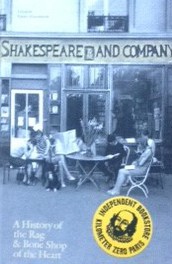Inspiring Older Readers
 posted on 29 Dec 2016
posted on 29 Dec 2016
Shakespeare and Company, Paris: A History of the Rag & Bone Shop of the Heart edited by Krista Halverson
I guess that all obsessives have their iconic destinations – cricketers revere Lords, tennis players have Wimbledon, jazz fans fantasise about the Cotton Club and bibliophiles, like me, have Shakespeare and Co. This book, that has been pulled together by Krista Halverson, presents itself as a ‘history’ of this bookshop and the cultural phenomenon it has come to represent but it is in reality a sort of chronological scrapbook of short essays, memories, photographs and assorted ephemera hung around a simple historical narrative of the shop’s progress.
The shop itself has had three quite different incarnations – it’s founding years under the stewardship of the famous Sylvia Beech, it’s counter-cultural years presided over by George Whitman and its current incarnation under the ownership of Whitman’s daughter – also a Sylvia – and her husband. A short essay at the beginning deals with the Beech years prior to closure in 1941 under German occupation and the final section looks at the post 2000 years and speculates on the future but the vast majority deals with Whitman’s years and, in particular the role the shop played in the counter-cultural activities of the 60s and early 70s.
The shop was a magnet for so many writers – especially ex-patriot Americans and Brits hoping to find the time and space to develop their careers. Usually penniless and desperate for sanctuary, Whitman was on hand to offer a bed in exchange for a little free time working in the shop and the submission of a one page ‘biography’. These wandering souls became known as the ‘Tumbleweeds’ – Whitman’s own American heritage coming through in the name he chose – and this tradition of sanctuary became a key part of the building of the shop as a cultural and community destination.
Whitman was no business man but he not only made a success of the shop he also managed to consistently expand it. Often a chaotic hand to mouth venture, Whitman management style seemed to veer between demanding complete control and neglect of the shop in equal measure – he would go off travelling for months on end leaving the shop in the hands of inexperienced and temporary shop assistants.
What can’t be denied is that for the best part of two decades and before France made itself in the mid-70s a much less hospitable place for foreigners to stay, Shakespeare and Co. Mark II was essential to the development of the Beat movement and was directly responsible for other shops – City Lights, for example – trying to replicate their community environment. Selling books was clearly at the heart of the enterprise but just as important were the formal and informal literary happenings that would take place on a regular basis.
The title of this book incorporates George Whitman’s often planned but never completed venture – the story of his Shakespeare and Co. He appropriated and slightly amended the Yeats line ‘the foul rag and bone shop of the heart’ but never got much beyond deleting the word ‘foul’ because he never thought he could better the title. This book tries to make good on plan to document the shop’s history and it looks like a daunting and rather hefty 400 page read but it really isn’t. In many ways the book is a short historical essay supplemented by memories, letters and essays by writers, critics and ‘tumbleweeds’ that can be dipped into on an as-and-when basis and enjoyed at leisure.
The photographs and creative comic graphics are the real joy of this book and they more that anything help to create the sense of place. Having just been released this is not a cheap volume to buy - £25 – but if you are fascinated by bookshops and the role they can play in communities, this is an indispensible gift to buy yourself.
Terry Potter
December 2016